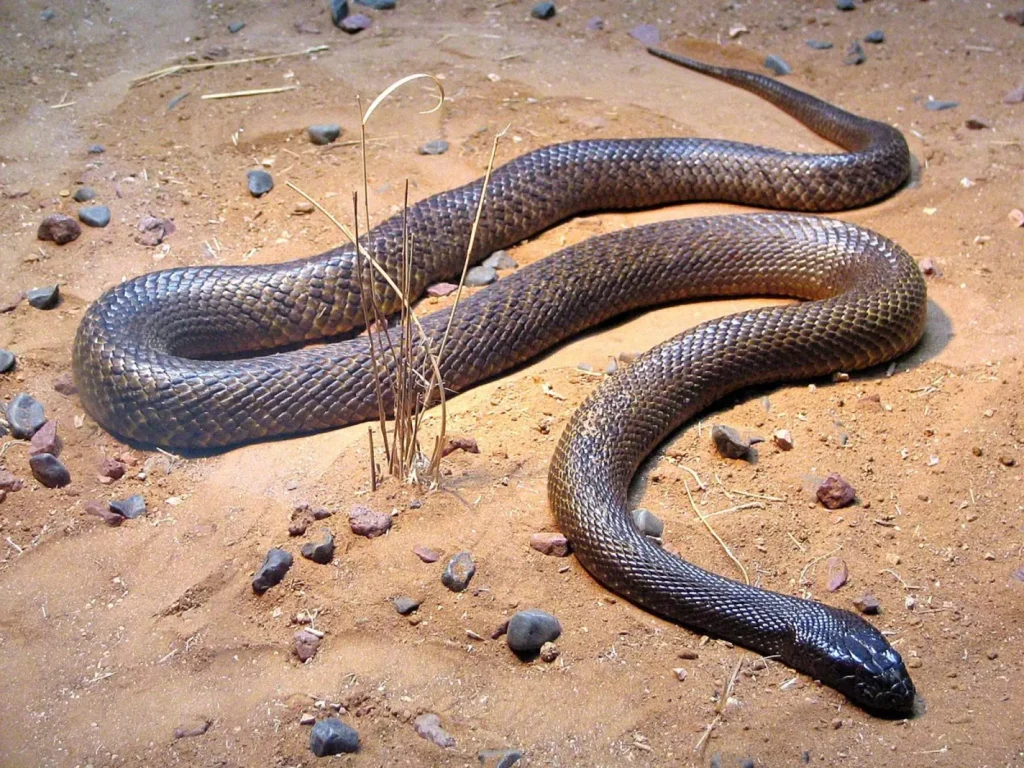When we think about The Inland Taipan: The Most Venomous Snake in the World , the Inland Taipan (Oxyuranus microlepidotus) often comes to mind. This remarkable reptile, often referred to as the “fierce snake,” has earned a reputation that both intrigues and terrifies. In this article, we’ll delve into the life of the Inland Taipan, exploring its characteristics, habitat, behavior, and the important role it plays in the ecosystem.

Characteristics
The Inland Taipan is a striking snake, and its appearance is as noteworthy as its venom. Adults typically measure between 2.5 to 3 meters (8 to 10 feet) in length, with some exceptional individuals reaching even longer. Their coloration varies significantly, often ranging from a dark brown to a lighter tan or olive hue. Interestingly, their skin can change color slightly with the seasons, becoming darker during the cooler months and lighter in the heat of summer. This ability to adapt its coloration aids in camouflage, allowing the snake to blend seamlessly into its arid surroundings.
One of the most astounding features of the Inland Taipan is its fangs, which can grow up to 1.2 centimeters (0.5 inches) long. These long, hollow fangs are specially designed to deliver venom deep into the body of their prey. The venom of the Inland Taipan is often considered the most toxic of any snake species. It contains a mix of neurotoxins and hemotoxins that can lead to rapid paralysis and severe internal bleeding in its victims. In terms of raw potency, a single bite could contain enough venom to kill 100 adult humans. However, despite its lethal capabilities, the Inland Taipan rarely poses a threat to humans due to its reclusive nature.
Habitat
Inland Taipans are primarily found in the arid regions of central Australia, particularly in the semi-desert areas of Queensland and South Australia. This species thrives in environments characterized by sparse vegetation, rocky outcrops, and open grasslands. The combination of heat and limited water sources defines its habitat, making it particularly well-suited to the harsh Australian interior.
These snakes tend to take refuge in burrows or under rocks, where they can avoid both the scorching sun and potential predators. The remoteness of their habitat significantly reduces encounters with humans, which is fortunate considering the snake’s lethal potential. While they can be found in a variety of terrains, their preference for isolated areas contributes to their reputation as elusive and rarely seen.
Behavior
Contrary to what one might expect from the world’s most venomous snake, the Inland Taipan is typically shy and reclusive. Its first instinct when confronted is to flee. This behavior is a significant factor in why bites to humans are exceedingly rare. Most interactions occur when the snake is accidentally stepped on or provoked, leading to defensive bites rather than aggressive attacks.
The Inland Taipan is primarily diurnal, meaning it is most active during the day. During these hours, it employs a hunting strategy known as ambush predation. The snake relies on its keen sense of smell and sight to locate prey, which primarily consists of small mammals. Once it identifies its target, the Inland Taipan strikes with remarkable speed, injecting venom and then swallowing its prey whole. The venom works quickly, paralyzing the prey and allowing the snake to consume it without resistance.
While the Inland Taipan is highly skilled in hunting, it is also an intelligent and adaptable predator. Studies have shown that these snakes can learn from their environment, adjusting their hunting strategies based on factors such as prey availability and environmental conditions.
Reproduction
Inland Taipans are oviparous, meaning they lay eggs. Mating typically occurs in the spring, after which females lay between 10 to 20 eggs in a hidden location, such as a burrow or under debris. The eggs incubate for approximately two months before hatching, with hatchlings emerging at around 20 to 25 centimeters (8 to 10 inches) long. Like adults, juvenile Inland Taipans are born with fully functional venom and hunting capabilities, although they tend to be more cautious in their behavior.
Conservation Status
The Inland Taipan is currently classified as “Least Concern” by the International Union for Conservation of Nature (IUCN). While the species faces potential threats from habitat destruction and climate change, it is not considered endangered. The snake’s preference for remote habitats, combined with its low population density, contributes to its stable status in the wild.
Despite its fearsome reputation, education and awareness are crucial in ensuring the continued safety of both the Inland Taipan and humans. Misunderstandings about venomous snakes often lead to fear-driven extermination efforts. By fostering respect and appreciation for these remarkable creatures, we can work towards coexisting peacefully with the wildlife around us.
Conclusion
The Inland Taipan: The Most Venomous Snake in the World , showcasing a combination of extraordinary characteristics and behavior that captures our imagination. Its incredible venom, striking appearance, and unique behaviors contribute to its status as a fascinating yet fearsome creature. Understanding and appreciating this species is crucial for conservation efforts and fostering a harmonious relationship between humans and wildlife. As we continue to explore and protect our natural world, we must remember that even the most fearsome among us has a vital place in the tapestry of life. By respecting and safeguarding the Inland Taipan, we can ensure its survival for generations to come.

























